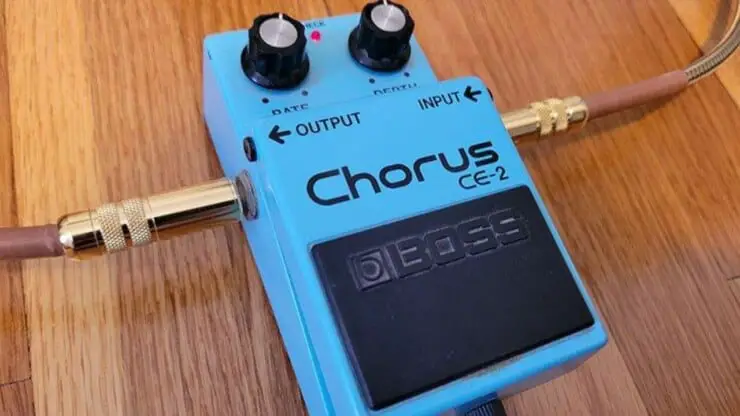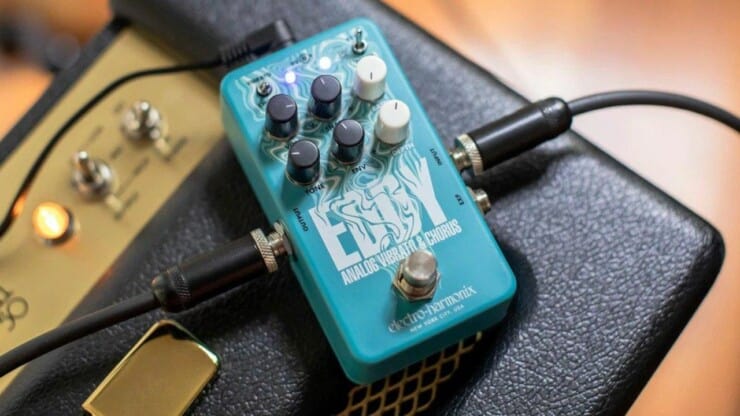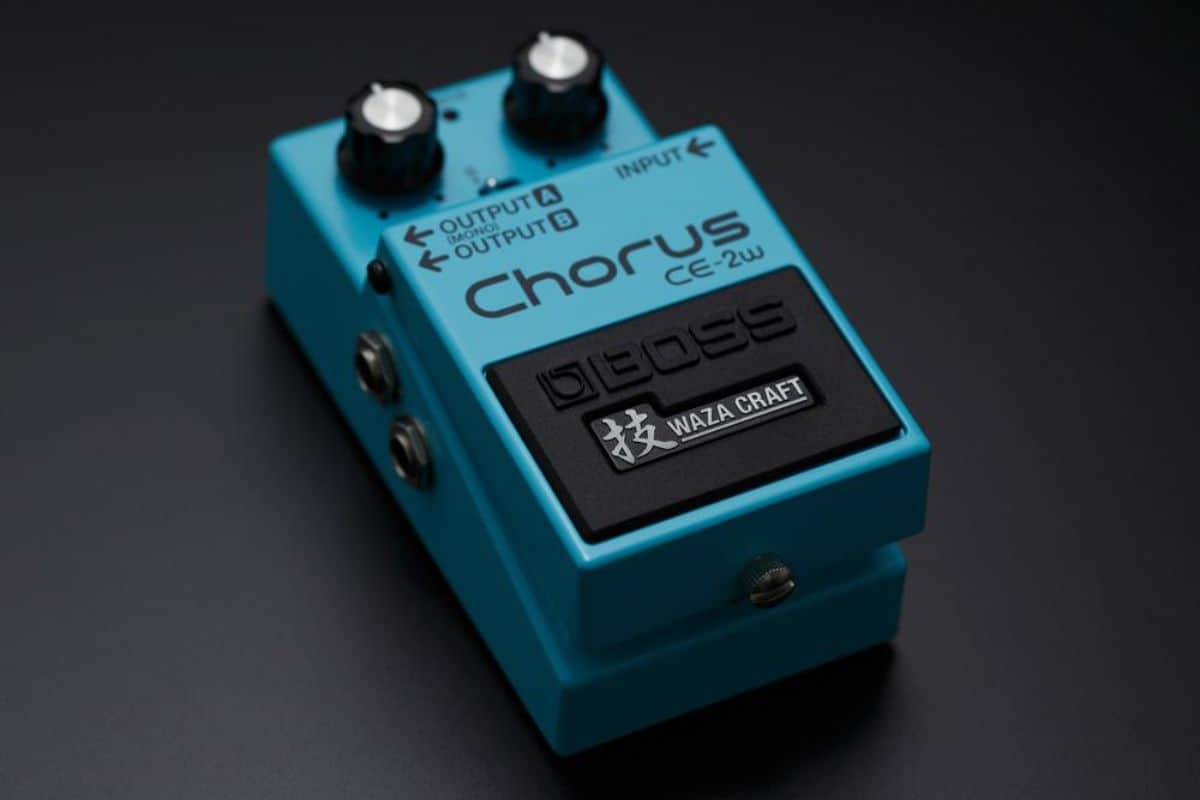Have you been trying your hand at different effects, but struggling to work out the chorus pedal effect? If so, then you are in the right place. You’ll get all the answers here.
A Chorus pedal does a great job in helping you achieve the shimmering, wobbly effect. It is designed to replicate the sound of multiple instruments that are playing at the same time.
In this article, you’ll get to know all about the chorus effect, what is a chorus pedal, what does a chorus pedal do, how does a chorus pedal work, the chorus pedal controls, and a lot more. Stick around to know all the answers that you’re looking for.
What is a chorus effect?
The chorus effect is an effect that can make a single musical instrument sound like two instruments being played simultaneously. They’ll add a rich, lush, shimmering quality to your guitar’s sound.
Chorus stompboxes and effect multiprocessors with chorus settings can easily alter the original signals coming from the guitar. This happens as they add a second sound with a little delay and subtle pitch differences. The effect will be similar to the ringing and chiming sounds that 12-string guitars produce naturally. This is the case due to the paired strings that differ in pitch and time.
On electric instruments like guitars, the chorus will sound like the same signal running through two amps with a slight delay between them. There is even a subtle pitch difference. The first chorus pedal was actually the BOSS CE-1, and it debuted in 1976. It was based on a circuit found in the Roland Jazz Chorus, the parent company of BOSS. The CE-1 is a great chorus pedal, and it is highly prized for its swirly, shimmering sound quality. The BOSS CE-1 was shortly followed by the compact BOSS CE-2 and an entirely new category of pedals was born. It featured iconic designs coming from some of the big names in the emerging pedal industry.
Chorus effects can easily fatten up the sound of the bass, solo guitar, or rhythm guitar. These can be used with distorted sounds, but they’re a fantastic way of creating full-sounding clean sounds too. Used with stereo arm rigs, the chorus effect will add spaciousness. Many acoustic guitar amps feature a clean-sounding chorus effect, adding character and depot to the amplified signal. Chorus pedals can be quite helpful in fattening the tone of acoustic-electric guitars, whose piezo pickups sound a bit thin.
What is a chorus pedal?
A chorus pedal is essentially a guitar effects pedal that’ll produce a shimmering, wobbly effect. It is designed to specifically replicate the sound of multiple instruments being played at the same time. It can be achieved by making alterations to the pitch and timing of dry signals. The warm, shimmering sound courtesy of the chorus effect is one of the most recognizable guitar sounds in modern music.

Whether it’s offered by old-school effects pedals or modern software equipment, this effect will include a number of standard controls. Some of those controls include depth and the rate that can be altered depending on your requirements. Most guitarists use a chorus effect pedal or a stompbox to get the chorus sound.
How does a chorus pedal work?
Chorus, as a musical effect and as is named, tries to replicate the choral effect of multiple voices or instruments. All of these voices and instruments simultaneously hit the same notes at the same time. Due to the unique nature of the human voice, the chances of different musicians singing the exact right note at the same time will be extremely slim. It means that when you’re hearing a big group of people singing the same thing at the same time, the natural chorus effect will be produced. Keeping that in mind, the first thing that the chorus effect does is that it splits the signal. One of the signal paths will remain unaffected at all times, whereas the others feature detune and a slight delay on it.
There are two parameters that decide the classic controls of the chorus effect. Once the effect is placed on the signal, it can be put back together and go on to the output.
- Rate – It is the speed at which the detune occurs. This is handled by what is referred to as Long Frequency Oscillation (LFO). Rate controls how fast the wave goes from the bottom of the wave all the way to the top.
- Depth – Depth defines how far the wet signal has been detuned.
Very often, there are level and tone controls too alongside the two parameters mentioned above, and they’re fairly simple. The level control will be present as you’re stacking up multiple signal paths. As the signal starts getting louder, a level control will be used to ensure the signal doesn’t suddenly jump in. The tone control is often a Low Pass Filter or LPF that gradually rolls off the top end. More advanced chorus pedals come with a mix control that allows you to change the ratio of the dry signal. Meanwhile, most regular pedals tend to go for a 50-50 split. You can easily get your hands on lovely tones by messing with the mix signal. You can include a vibrato effect if you’re looking to get the mix set to 100% wet.
Standard chorus pedal controls to get the chorus effect
To get the chorus pedal working, you’ll need to know the standard controls of the chorus pedal. The standard controls on the chorus pedal include depth, rate, and mix. Certain chorus pedals also come with delay and shape controls, giving you the ability of sonic adjustment. Not all chorus pedals will include every single one of these controls. Pedals like MXR Micro Chorus or Electro-Harmonix Small Clone feature a single knob, which allows you to adjust the rate of the chorus effect. Meanwhile, pedals like the BOSS CE-5 and Strymon Ola features all the standard parameters and a lot more.
Chorus rate control
The rate parameter on the chorus pedal will control the speed of the modulation effect. A chorus pedal will incorporate a low-frequency oscillator to generate the modulating chorus effect. The rate knob will adjust the speed or rate of this LFO. Rate is often substituted for a speed setting and vice versa. A high rate setting produces a fast, vibrato-like tone, whereas a small setting generates a more subtle, gradual modulation effect.
Chorus depth control
The depth parameter on the chorus pedal will control the amount of pitch-shifting that the effect produces. Part of what gives the chorus effect the distinct “wobbly” quality is the detuning of the double audio signal. A higher setting on the depth knob will increase the amount of pitch shift, lessening the subtlety of the chorus effect.
Chorus delay control
The delay parameter on the chorus pedal will control the amount of delay between the dry, unaffected signal and the wet, doubled signal. The delay can be measured in milliseconds, and it’s often labeled this way due to chorus stompboxes. More commonly, the knob comes with an indication of minimum and maximum, with no specific values.
The length of delay time is something that distinguishes a chorus pedal from a flanger, another common modulation effect. Delay times on a chorus pedal can run longer than flanger effects, often ranging between 20 and 50ms.
The chorus delay parameter might also be called the voice, ambiance, or tune. You can think of delay settings as a sort of stickiness or glue. The longer the delay setting is, the more space exists between the original, dry signals and the doubled, wet signals.
Chorus shape
The shape parameter on the chorus effect will control the type of wave generated by the LFO. Normally, this parameter is controlled by the toggle switch between two options – a triangular wave and a sine wave.
With the toggle switch being set to the sine wave, the modulation sounds more gentle and easy. If the toggle switch is set to the triangular wave, the modulation would sound more aggressive and sharp. Occasionally, there might be settings for a square wave, which will sound somewhere in the middle of the triangular wave and the sine wave.
Mix/blend/effect level
The mix parameter on the chorus effect determines the ratio between the original, dry signal and the doubled, wet signals send to the outputs. You can keep it turned down low to get a subtle effect. Further, you can also dial it up to the maximum to get a wild, wobbly 80s vibe.
What does a chorus pedal do?
A chorus pedal is a great addition to your guitar rig, as it produces the wobbly effect designed to replicate multiple instruments playing simultaneously. This is done by making alterations to the timing and pitch of the dry signal. Most guitar chorus pedals come with controls like depth and rate as standards. These will control the depth and rate of the modulation effect, respectively. Chorus pedals normally output a stereo signal as they modulate the affected sound between the left and right output channels.
Chorus in a (stomp) box
The chorus effect pedal can mimic the sound quality of a group of vocalists singing the same melody in unison. Although each vocalist may be singing the same notes in the same order, there will be slight differences in the pitch and timing between individual singers. This combines to create a broader, lusher, and more complex sound than the one created by a solo singer.
Another example of this effect would be the rich sound of a strict section vs. the small sound of a single violin. To accomplish this effect electronically, a chorus pedal will manipulate the audio signal from the guitar. Then, double the signal before processing it with a combination of delay and pitch shifting. This will help you deliver a warmer, broader tone.
As far as guitarists go, you’ll need two of them playing right next to each other to create something similar. However, it still wouldn’t create the complex overtones that some of the chorus pedals produce. Luckily for guitarists, the chorus effect is built to give guitars the same spacious sound. It’ll work by taking a guitar signal and then applying a short delay. Then, it’ll slightly alter the timing of the delay at specific intervals. Then, it’ll mix the augmented signal with the original, unaltered signal.
You should think of it as playing while having someone twist the timing knob on the delay pedal back and forth. The pitch will speed up once the delay time is decreased and drop once the delay time is increased. Now, you should imagine the same thing, but in small increments and with perfect consistency. This altered signal may sound like a simple vibrato on its own. When it’s mixed with a clean signal and spread over a stereo field, it’ll create the watery, specious chord sound that chorus pedals are known for.
What do the knobs on the chorus pedals do?
Most chorus pedals come with at least a Rate and a Depth knob, or sometimes a variation of the two. Some will also have many other setting options, but these controls are the foundation of the chorus pedals. These knobs are known for controlling the intensity of the effect. The rate knob will change the speed at which the delayed signal will be played back. This can range from short and right modulation to detuned amazingness. The depth knob will change the amplitude of the chorused signal. Keep it in mind, as this will be useful in deciding how much chorus you’re going to hear coming out of the pedal. You can use it for sprinkling in the effect, or you can go all-out in pop-rock glory.
What type of guitarists make use of chorus pedals?
A chorus pedal might be all that you need, whether you’re seeking a thicker amp sound or if you’re an acoustic guitarist looking to get a warmer sound. If you want to liven up the clean sound as a rhythm guitarist, or you just hope to thicken the screaming lines as a shredder. This versatile pedal will have something for everyone.
Interestingly, the list doesn’t end there. You can use a chorus pedal if you’re looking to replicate the classic 80s rock/pop guitar tone. A chorus pedal is a handful for guitarists, and this is why you must invest in the best chorus pedals. Although you will likely face many options when you’re scrambling to get your hands on the best chorus pedals, you should ensure that you have adequate research before deciding. With a high-quality chorus pedal, you will have everything needed to create amazing tunes.

You can then use it on almost anything. You can use it on your bass, electric guitar, or even acoustic guitar. It’ll give a great accent to the bass guitar, while it will help you stand out in the mix. On acoustic guitars, the chorus pedal will thicken your signal when playing solo while helping you look at the acoustic part in a different light. With proper tweaking, you’ll have the chorus on everything. But as the famous saying goes – with great power comes great responsibility. The chorus effect can often be overdone, so it is recommended that you should keep it in check. It is recommended that the chorus effect is best when used sparingly as a flavor for the tone and not the entire meal.
Conclusion
Thank you for reading. Hopefully, now you know a lot more about what is the chorus effect, what is a chorus pedal, what does a chorus pedal do, how does a chorus pedal work, the chorus pedal controls, and more. The chorus effect is something that makes a single instrument sound like multiple instruments being played simultaneously. A chorus pedal will add a rich, lush, and shimmering quality to your guitar’s sound. The chorus pedal achieves this by making slight alterations to the timing and pitch of dry signals. To get this pedal working, you’ll require the standard controls of the chorus pedal – depth, rate, and mix.
Image Credit:
Featured Image: Boss
Images: Hexacord, Musician’s Friend



